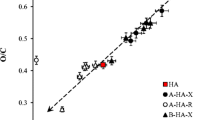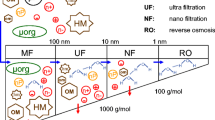Abstract
A commercial humic acid dissolved in water was fractionated to nine samples by means of ultrafiltration (UF); the nominal molecular weight used for UF membranes was 1 k–200 kDa. Concerning the nine samples, copper(II) complexing capacities (CuCC) and conditional stability constants (β) of the formed copper(II) complexes were measured by a solvent extraction method. A total organic carbon (TOC) and the UV-VIS absorption ratio (E350 nm/E450 nm) were also measured. From a comparison of these data, it was found that a) humic acids in each fraction formed two kinds of copper(II) complexes with different stability; b) the βvalues obtained from each fraction were almost the same; c) large CuCC values were observed in the molecular weight range from 10 kDa to 20 kDa and below 1 kDa; d) molecules with molecular weight higher than 50 kDa scarcely had any copper(II) complexing ability; e) the values of CuCC/TOC of each fraction were in the range from 1.7 to 3.4 × 10–7 mol mg–1.
Similar content being viewed by others
References
A. Teesier and D. R. Turner (ed.), “Metal Speciation and Bioavailability in Aquatic Systems”, 1995, John Wiley and Sons, Chichester.
L. Pitts, R. Cornelis, H. Crews, O. F. X. Donard, and P. Quevauviller, “Trace Element Speciation for Environment, Food and Health”, 2001, The Royal Society of Chemistry, Cambridge.
A. M. Ure and C. M. Davidson, “Chemical Speciation in the Environment”, 2002, Blackwell Science, Oxford.
D. O. Hessen and L. J. Tranvik, “Aquatic Humic Substances Ecology and Biogeochemistry”, 1998, Springer, Heidelberg.
E. A. Ghabbour and G. Davies, “Humic Substances Versatile Components of Plants, Soil and Water”, 2000, The Royal Society of Chemistry, Cambridge.
E. A. Ghabbour and G. Davies, “Humic Substances Structures, Models and Functions”, 2001, The Royal Society of Chemistry, Cambridge.
P. Burba, B. Jakubowski, and J. Van den Bergh, “Refractory Organic Substances in the Environment”, ed. F. H. Frimmel, G. Abbot-Braun, K. G. Heumann, B. Hock, H.-D. Ludemann, and M. Spiteller, 2002, Chap. 2, VCH, Weinheim, 73.
H. Itabashi, Y. Shigeta, H. Kawamoto, and H. Akaiwa, Anal. Sci., 2000, 16, 1179.
H. Itabashi, D. Yamazaki, H. Kawamoto, and H. Akaiwa, Anal. Sci., 2001, 17, 785.
M. R. Servos, D. C. G. Muir, and G. R. Barrie Webster, Aquat. Toxicol., 1988, 14, 169.
D. R. Van Stempvoort, J. M. Molson, S. Lesage, and S. Brown, “Humic Substances Versatile Components of Plants, Soil and Water”, ed. E. A. Ghabbour and G. Davies, 2000, The Royal Society of Chemistry, Cambridge, 153.
E. B. Sandell and H. Onishi, “Photometric Determination of Traces of Metals, Part I”, 1978, John Wiley and Sons, New York, 927 and 934.
P. Burba, V. Shkinev, and B. Y. Spivakov, Fresenius J. Anal. Chem., 1995, 351, 74.
A. E. Martell and R. M. Smith, “Critical Stability Constants, Volume 1”, 1974, Plenum Press, New York.
Author information
Authors and Affiliations
Rights and permissions
About this article
Cite this article
Itabashi, H., Kamata, Y., Kawaguchi, D. et al. Evaluation of the Copper(II) Complexing Ability of Ultrafiltered Humic Acid by the Solvent Extraction Method. ANAL. SCI. 19, 1277–1280 (2003). https://doi.org/10.2116/analsci.19.1277
Received:
Accepted:
Published:
Issue Date:
DOI: https://doi.org/10.2116/analsci.19.1277




